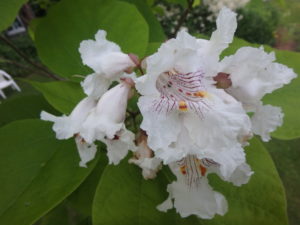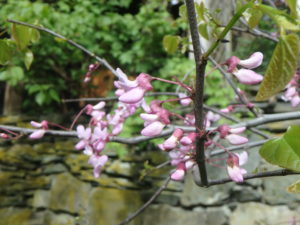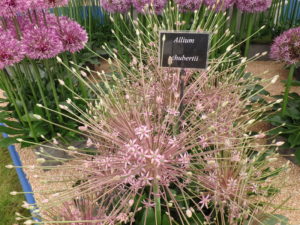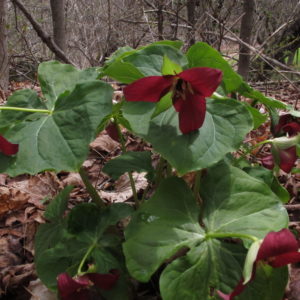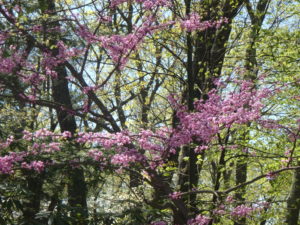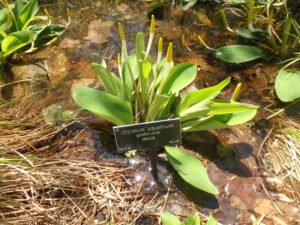Holiday Reflections
At this time of year I like to look back on the past year – in the garden, and in my life – to reflect on all the wonderful events of the year. I take time to count my blessings, look at my mistakes, and make plans for the future.
It was a good year in the garden. It started off hot and sunny, perfect for growing vegetables. Later in the summer we got a bit too much rain, which can encourage fungal diseases. But overall my tomatoes did well and produced plenty, as did my leafy greens and squashes.
My potatoes, on the other hand, were miserable. I planted them on the south side of my garden where there is a big magnolia that shades the garden during the afternoon, when the sun is strongest. Perhaps the magnolia roots were competing with the potatoes, too. No potato bugs, but still, very few spuds. And most were small. I am already buying potatoes, which is unheard of at this time of year.
Last year I harvested 100 pounds of potatoes and had plenty to give away. This year? Maybe 10 pounds. Lesson learned? Plant leafy greens, not potatoes, tomatoes or squash family veggies on the shady side of the garden. Lettuce, kale, spinach and such need less sun, but I knew that. My bad.
In 2017 I planted a nice 10-foot tall catalpa tree, and it over-wintered nicely. It bloomed this year, and I loved the sight and fragrance of the blossoms. It had some good growth, and I look forward to an even better display of blossoms next year. And I learned not to worry if it doesn’t leaf out early in the spring. It is one of the last to open up its leaves.
I have always loved the eastern redbud tree (Cercis canadensis). Unlike anything else I grow, it does not set flower buds on twigs. The blossoms pop out of the bark of the tree or the branches. And they are a bright magenta color. There is also a white variety, but I got the pink one.
I had tried growing a redbud 25 years ago, but it died back to the ground each winter, and never blossomed, so I eventually gave up on it and dug it out. But our climate has warmed some, and I placed this one in a protected spot near a tall stone wall that will radiate some heat and break the winds of winter. It bloomed nicely for me this year, and I have great hope that it will winter well.
I have noticed that I am getting more adventurous as I age. I am more willing to try plants that are marginal in our climatic zone. Now I am also spending more and getting bigger trees, despite the increased costs. Knowing that I have a finite time on this earth, and that I’m past 70 years young, I want to see my trees come to maturity – and soon.
I remember helping artist and author Tasha Tudor some years ago to find some uncommon crab apple varieties when she was in her nineties, and being amazed that someone of that age was still planting trees. I use her as my role model as I age.
I am grateful to have had a young person helping me in my garden again this year. Celia is a high school student that loves working in the garden and has high energy, literally skipping from job to job. I resolve to never become a curmudgeon who says all kids are lazy or addicted to their cellphones. Many want to learn and are willing to work hard, and having a helper even 4 hours a week is a big help.
In the fall of 2017 I ordered allium bulbs because I had seen some amazing varieties at the Chelsea Flower Show in London. The Brits use alliums much more than we do, and I fell in love with them. One of those I loved the most, Allium schubertii, is not hardy in my climatic zone, but I ordered them anyway and planted them in pots. I kept them in a cold basement, and brought them into the warmth of the house in March. They bloomed fabulously.
My thanks to you, my readers, for asking me questions and keeping learning. My best wishes for 2019.
Henry can be reached at PO Box 364, Cornish Flat, NH 03746 or henry.homeyer@comcast.net.
Spring Wildflowers
Every spring Mother Nature gives me gifts. Or that is how it seems when she sends the blossoms of trillium, hepatica, Jack-in-the Pulpit, bloodroot, trout lily, blue cohosh, Dutchman’s breeches, squirrel corn and more to my woods and shade gardens. Of course, I have helped nature by planting wild flowers in places where I know they will be happy.
Some wild flowers I find elsewhere on my property and move to more visible locations. Others I dig from the woods of friends who are willing to share. For the rarer things, I have found garden centers and bulb companies that have sold me plants, bulbs or roots.
One of the best ways to succeed in the garden is to do your homework. Know what an individual plant needs, and what other plants grow in the same environment as the plants you wish to grow. If trillium grows in my woodlands, I can be pretty sure that Jack-in-the pulpit will do well there, too, for example, because they grow together in the wild.
In nature plants live in communities, and when designing gardens it’s important to consider that. I plan to attend a hands-on design workshop with author Claudia West in Windham, Vermont about this topic on June 9. If you are interested in attending this all-day workshop, e-mail cheath58@gmail.com. It’s a Master Gardener workshop, but open to all who are interested. Fees apply.
But what can you do if you are just starting a woodland garden, and don’t know what plants grow in areas like those you have? Visit other gardens. Walk in the woods, and observe what grows together. A maple and beech forest is quite different than one dominated by hemlocks and pines, even if a few of the others are there. Pay attention. Learn names.
I recently visited an amazing display of spring wild flowers at Garden in the Woods, in Framingham, Massachusetts. This 45 acre site is 20 miles west of Boston. The month of May is the peak bloom time, but many wildflowers continue to bloom in June, and throughout the summer. Not only that, they have an extensive nursery that sells wildflowers that I have never seen and only dreamed of growing.
My partner Cindy Heath and I walked around the property with Mark Richardson, Garden Director, and the co-author of the lovely paperback, Native Plants for New England Gardens. We were there on May 9, smack dab in the middle of Trillium Week. Garden in the Woods grows 21 of the 30 species of trillium that are native to the United States, Richardson told me. Not all were in bloom, but I saw several spectacular types.
Of the trees in bloom, two trees nearly made my heart stop with their beauty. First was the redbud (Cercis canadensis), a fine specimen of which was blooming right at the entrance. This tree, Richardson explained, exhibits cauliflory, meaning that it flowers directly on the trunk or branches of a woody plant. It has small fuschia-colored flowers that seem to pop right out of the trunk at random.
Redbud is hardy to zone 4, and is an understory tree, or one that blooms at the edges of woods. I had purchased one the week before coming to The Garden in the Woods, so seeing it there, in the woods, gave me a better idea of where to plant it in my garden.
The other tree in bloom that I saw (and bought) at Garden in the Woods is Carolina silverbells (Halesia tetraptera). Like redbud, this is a small tree for part shade and hardy to Zone 4. It has small white flowers that hang from branches before leaves appear. Mine has yet to flower or show leaves, but I am hoping to see flowers soon.
I asked Richardson to name a few of his favorite spring flowers. He explained that he liked some of the common ones, that rare flowers are not necessarily the most alluring to him. He mentioned blue cohosh (Caulophyllum giganteum), moss phlox (Phlox subulata) and pinkster bloom azalea (Rhododendron periclymenoides).
I also asked Debbi Edelstein, Director of New England Wild Flower Society, what her favorite spring flowers are. She e-mailed her response, saying, “My favorite part of spring isn’t the reappearance of particular plants, but the explosion of different shades of green and the layers of textures and colors.” I agree. I look forward each spring to the day the sugar maple on the east side of my house first displays its leaves. When the morning sun comes through the leaves I feel so lucky to be alive.
Edelstein continued, saying “That said, who doesn’t love a redbud (Cercis canadensis) in full bloom? At the Garden this time of year, I’m also drawn to the golden club (Orontium aquaticum), which is rare in New England and is weird and elemental and probably overlooked by most people; and Trillium erectum (red trillium or red Wake-robin), because it’s a deep red and is more delicate and less glamorous than, say Trillium grandiflorum.
So go out, look for wildflowers, and plant a few.
Read Henry’s blog posts at https://dailyuv.com/



